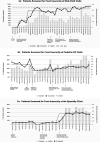Improving food insecurity screening across a health system throughout the COVID-19 pandemic
- PMID: 38296603
- PMCID: PMC10831437
- DOI: 10.1136/bmjoq-2023-002462
Improving food insecurity screening across a health system throughout the COVID-19 pandemic
Abstract
Background: Food insecurity has direct and indirect negative outcomes on the physical and mental health of children, with impacts throughout adult life. Rates of food insecurity have increased dramatically since the start of the COVID-19 pandemic. The American Academy of Pediatrics recommends paediatricians screen and intervene to address food insecurity. We aimed to increase the percentage of patient encounters with food insecurity screening completion at the paediatric medical home from 0% to 85% by July 2020 with extension to the paediatric emergency department (ED) and paediatric specialty clinic in the following year.
Methods: This multicentre project occurred in three sites within our health system: a teaching safety-net, paediatric medical home; a paediatric ED; and five divisions within paediatric specialty medical clinics. A screening tool was created using the validated Hunger Vital Sign Questionnaire. A standard screening, documentation and referral process was developed. The Model for Improvement was used testing changes via Plan-Do-Study-Act cycles.
Results: The percentage of households screened for food insecurity increased from a median of 0% to 30% for all sites combined. There was significant variability in screening with the ED screening a median of 24% and the medical home screening 80% by the end of the study period. A total of 9842 households (20.9%) screened were food insecure. During the study period, 895 families with 3925 household members received 69 791 pounds of food from our primary community resource using our clinic's food prescription. Of these families, 44% (398) also qualified for the US Department of Agriculture programme ensuring ongoing food distribution up to twice a month.
Discussion: Using quality improvement methodology to address a critical community need, we implemented food insecurity screening across a hospital system including multiple sites and specialties and provided critical resources to households in need.
Keywords: Ambulatory care; Continuous quality improvement; Emergency department; Paediatrics.
© Author(s) (or their employer(s)) 2024. Re-use permitted under CC BY-NC. No commercial re-use. See rights and permissions. Published by BMJ.
Conflict of interest statement
Competing interests: None declared.
Figures


Similar articles
-
Food insecurity among households with children during the COVID-19 pandemic: results from a study among social media users across the United States.Nutr J. 2021 Aug 30;20(1):73. doi: 10.1186/s12937-021-00732-2. Nutr J. 2021. PMID: 34461913 Free PMC article.
-
Food insecurity during COVID-19 in children with end-stage kidney disease: a pilot study.BMC Pediatr. 2022 Jul 15;22(1):420. doi: 10.1186/s12887-022-03472-2. BMC Pediatr. 2022. PMID: 35840894 Free PMC article.
-
Food Insecurity and Perceived Effects of COVID-19 on Livelihoods in Rural Sri Lanka.Food Nutr Bull. 2023 Dec;44(4):229-239. doi: 10.1177/03795721231197249. Epub 2023 Sep 13. Food Nutr Bull. 2023. PMID: 37700715 Free PMC article.
-
Food Insecurity and the Hispanic Population during the COVID-19 Pandemic.Ecol Food Nutr. 2021 Sep-Oct;60(5):548-563. doi: 10.1080/03670244.2021.1974014. Ecol Food Nutr. 2021. PMID: 34617866 Free PMC article. Review.
-
Food insecurity in children and adults with food allergies.Ann Allergy Asthma Immunol. 2022 Oct;129(4):424-429. doi: 10.1016/j.anai.2022.08.012. Epub 2022 Aug 18. Ann Allergy Asthma Immunol. 2022. PMID: 35987455 Review.
Cited by
-
Food Insecurity Among LGBQ+ Veterans.JAMA Netw Open. 2024 Nov 4;7(11):e2442979. doi: 10.1001/jamanetworkopen.2024.42979. JAMA Netw Open. 2024. PMID: 39495510 Free PMC article.
-
Childhood Food Insecurity Trajectories and Adult Weight and Self-Reported Health.Am J Prev Med. 2025 Aug;69(2):107647. doi: 10.1016/j.amepre.2025.107647. Epub 2025 May 6. Am J Prev Med. 2025. PMID: 40339828
References
-
- US Department of Agriculture . Measuring US Household Food Security, . 2005Available: www.ers.usda.gov/AmberWaves/April05/DataFeature [Accessed 22 Sep 2022].
-
- Bickel G, Nord M, Price C, et al. . Guide to Measuring Household Food Security, Revised. Alexandria, VA: USDA Food and Nutrition Service, Office of Analysis and Evaluation, 2000.
MeSH terms
LinkOut - more resources
Full Text Sources
Medical
